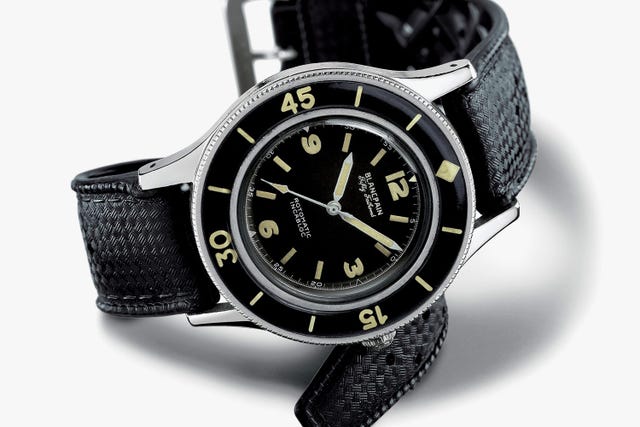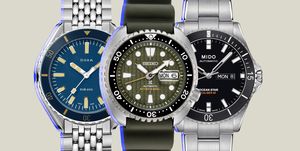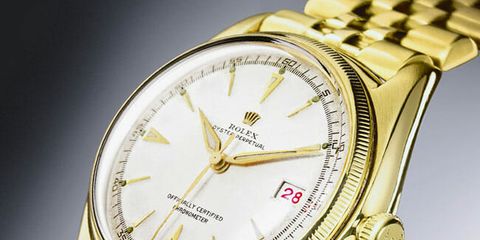Welcome to Watches You Should Know, a biweekly column highlighting important or little-known watches with interesting backstories and unexpected influence. This week: the Blancpain Fifty Fathoms.
The variations are endless, but you know a dive watch when you see one. It's not just water resistance, but a familiar combination of practical diving features that give the dive watch the basic, unmistakable form we know today. Though watchmaking typically advances incrementally — and technical progress had been building toward a dive-centric timepiece for decades — in 1953 the modern dive watch concept seems to have burst onto the scene fully formed.
It must've been demand, solid market research, and the advent of recreational diving that led three totally unrelated companies — Rolex, Zodiac and Blancpain — to introduce automatic dive watches with remarkably similar traits: they were water-resistant to roughly 100m, featured highly legible, luminous dials and included the most visually and functionally defining dive watch trait of all: prominent rotating bezels.
Rolex's Submariner became the most famous watch in history, of course, and Zodiac's Sea Wolf today offers an interesting and relatively affordable avenue to this heritage. Neither, however, has the compelling origin story of Blancpain's Fifty Fathoms, which was developed with military use in mind: It was made to the specifications of France's elite military unit known as the nageur de combat, the "combat swimmers," akin to American Navy SEALs.
It was Captain Robert Maloubier and Lieutenant Claude Riffaud of the combat swimmers who reached out to watch companies to create a diving watch with a black face, rotating bezel and dial markers that were bold, legible and glow-in-the-dark. Reportedly having been told by French watchmaker LIP that the design was "a portable clock without any future," they finally went to Blancpain, whose CEO was an avid amateur diver and already interested in making a dive watch.
Diving was still young and dangerous in the 1950s, and watches were actually critical equipment — whereas they function mostly as a backup for dive computers today. Aside from being water-resistant, the features requested for the French navy were those that any diver would need: Legibility in dark and/or murky water was addressed by prominent markers and luminous paint, and the rotating bezel could be aligned with the minute hand to time bottom time or the decompression stops necessary before surfacing.
The first Blancpain Fifty Fathoms was 42mm wide, which would have been seen as gargantuan at the time. It used double O-ring gaskets to seal the crown and achieved a water-resistance of 50 fathoms. Fathoms are a British unit of depth measurement equivalent to 6 feet or 1.83 meters, making the Fifty Fathoms rated to 300ft, or 91.5m. Though today's dive watches are mostly rated to at least 200m, each of the dive watches introduced that year was around 100m water-resistant.
Subsequent variations of the Fifty Fathoms increased water resistance, tweaked the design and added features. The model that ended up being issued to the frogmen later in the 1950s was one with a special feature: a large dot on the dial at 6 o'clock would change color if moisture was detected in the case. This wouldn't prevent damage to the watch but, rather, it would indicate to the diver whether or not his watch had been compromised. (A modern model with this featured is referred to as the Fifty Fathoms Mil-Spec.)
The Blancpain Fifty Fathoms is now a vast collection, having been reintroduced by the brand in 1997. However, today it feels far from its rugged roots and is a markedly upscale and refined luxury dive watch featuring the brand's high-end in-house movements. Its domed sapphire crystal bezel insert is particularly distinctive and lends it a character unlike that of any other diver.



















